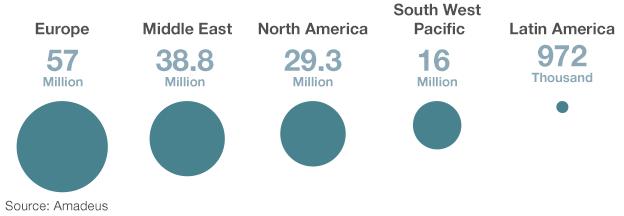Asia's global travel boom
- Published

Continental shifts are being made in terms of travel, tourism and spending power as more Asian, and especially Chinese, travellers are venturing abroad.
Western countries, such as the UK and France, are starting to tap into the trend by wooing Chinese visitors with simplified visa applications.
Rapid urbanisation, increased disposable income and a relaxing of travel restrictions have enabled more people to travel and budget airlines are opening up routes from India and other parts of Asia.
Asians travelling outside the region every year

The Chinese are taking the lead. China sits in third place behind France and the United States as a travel destination for the world's tourists, but millions of Chinese are now travelling abroad themselves.
International trips by Chinese travellers have grown from 10 million in 2000 to 83 million in 2012, according to the World Tourism Organization UNWTO.
Some analysts predict more than 100 million travellers will leave mainland China in the next 12 months - and when they travel, they spend.
Chinese travellers spent a record $102bn in international tourism in 2012, up 40% from 2011. That's more than the total for American or German visitors. In the first three quarters of 2013, China's expenditure increased by 28%.

How Asians rank among top travel spenders

The COTRI China Outbound Tourism Research Institute says the "New Chinese Tourists" are travel-savvy, well-educated and mostly under 45 years of age. COTRI's latest estimate is that Chinese travellers will spend a total $129 billion in the next 12 months, despite a slight slowdown in outbound travel compared with 2011/12.
"The new Chinese governments campaign against 'hedonism' and 'extravagance' will have some impact on official outbound travels which will however mostly be cancelled out by the growing demand for leisure trips especially from second- and third- tier cities in China," says COTRI's director Prof Dr Wolfgang Georg Arlt.
The Hurun Report into Chinese luxury travellers found that wealthy Chinese were travelling overseas on business less frequently for the first time in five years.
Reasons for travelling: Business or leisure?

By 2030, North East Asia is expected to be the most visited destination in the world, although Europe will be the most popular in terms of international arrivals in relation to population size.
A large proportion of the travellers between 2010 and 2030 will come from the Asia and Pacific region, according to UNWTO projections.
Among the most popular destinations for Asian travellers are other Asian countries.
The main destinations for departures from China are Hong Kong, Macau, South Korea and Thailand. Around 18.8 million visitors from mainland China visited Hong Kong in the first half of 2013, according to the local tourism board. The city's own population is only 7.1 million.
Where do Asian travellers go? (2012)

Chinese from the mainland are said to be attracted by the shopping - everything from luxury goods to baby formula - because Hong Kong has no sales tax and a reputation for authentic goods.
Travel to the United States has increased dramatically over the past six years from around 397,600 trips a year to 1.4 million, but travel to Japan and the UK has fallen slightly.
The Japan National Tourist Organization says the number of Japanese travellers to East Asian destinations such as Korea is still decreasing, with more Japanese travellers going to Vietnam, Thailand and Hawaii.
Among the top five destinations for Indian travellers are Singapore, UAE and Malaysia. Journeys from India to Thailand since 2007 have increased by more than 50%.
Euromonitor International says the South-east Asian destinations have been promoted aggressively by online travel agents and other via social media websites such as Facebook. Cheap deals meant outbound trips became more affordable to more Indian consumers, many of whom had never previously travelled outside the country.
The number of outbound travellers from India is expected to grow exponentially over the next 20 years, say industry analysts Amadeus, with the 4.5 million Indians travelling to Asia-Pacific destinations in 2011, increasing to almost 70 million by 2030.
Enticing travellers

Traditional destinations in Europe and countries within Asia are making efforts to make travel from China, in particular, easier by simplifying visa applications.
South Korea has removed the need for visas for Chinese travellers going directly to Jeju Island, allowed multiple-entry visas for teachers and offered benefits to timeshare owners. In return, Chinese arrivals have risen over the past five years.
In Europe, Germany and France opened a joint visa processing centre in autumn 2012 to speed up visa processing.
The UK, which boasts around 39 weekly services between London and four cities in China, has also announced a pilot scheme to allow selected Chinese travel agents to apply for UK visas by submitting the EU's Schengen visa form, rather than two separate applications, reducing duplication for agents taking tourists to both the UK and the Schengen area in Europe.
- Published11 July 2013
- Published5 January 2013